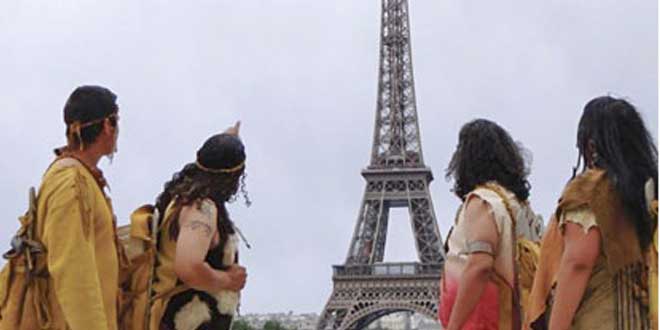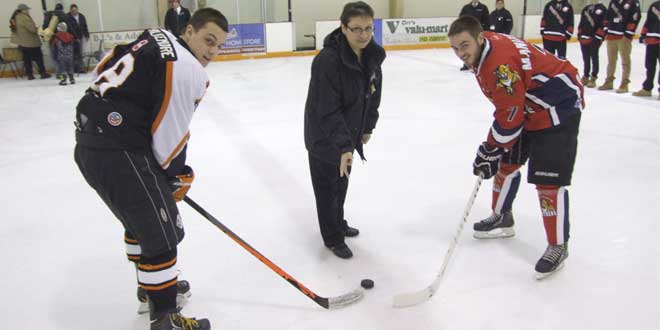MANITOWANING—A representative of the Royal Conservatory travelled from Toronto recently to learn more about the facilities available at the Debajehmujig Storytellers Creation Centre in Manitowaning in preparation for the Royal Conservatory offering the Artist-Educator Foundations Professional Training (the starting course of their outstanding Artist Education program) in collaboration with the Island theatre organization.
The Artist-Educator program is directed towards members of the arts community who may wish to also have a teaching role, such as through Ontario’s “Artists in the Schools” program where the Ontario Arts Council (OAC) funds artists to spend a week (or sometimes more) in a classroom or a school imparting skills and knowledge.
Artist participants in the Royal Conservatory’s Artist-Educator program gain valuable pedagogical skills they can use in situations where they are involved in a public school setting, or in any other area where they are cast in a teaching role.
Nicole Fougere, manager of artist education training at the Royal Conservatory, took a few minutes out of a whirlwind familiarization visit to speak about the program with The Expositor.
Ms. Fougere is much more than simply an education administrator. She is a dancer, choreographer and storyteller in her own right. “The power of the arts to positively transform lives and the role that the arts play has always been in my heart,” she said. The role of the Artist-Educator program is to assist artists to positively put the arts to work in their courses. The program, explained Ms. Fougere, is open to artists of all ages who are seeking professional development. “I firmly believe in lifelong learning,” she said.
The work the Royal Conservatory has been doing in the realm of artist education over the past decade and a half is being acknowledged all across the globe.
The OAC is playing a critical role in the program as well, noted Ms. Fougere. “Because the Ontario Arts Council are generously funding the program it is a lot more accessible to artists,” she said. “The funding is really important because the course usually costs $600, but OAC subsidizes, so the cost to the artist is only $60. That puts it within the reach of most, if not all, artists.”
The Royal Conservatory course consists of four levels, and it is the first, Foundations, that will be offered at the Debaj centre, explained Ms. Fougere.
Ms. Fougere said that the opportunity to work with Debaj on this project “is really exciting. The opportunity to partner with this fantastic and creative group at Debaj will help us to create a new and meaningful version of the course,” she said. “We will decide together what our creative processes will be.”
This is not the first time the Royal Conservatory has worked with indigenous partners, noted Ms. Fougere. “We have done some beautiful work with First Nations, Metis and Inuit in northern Alberta and in inner city Winnipeg, in the mountains of British Columbia and in Thunder Bay.”
“We have an Elder-in-Residence program that has been very well received in Alberta,” she said.
This will be the second collaboration for the Royal Conservatory on Manitoulin Island itself, she noted. “We did some wonderful work with the Rainbow District School Board,” she said. “That work informs us as well, but it is still very important to work with Debajehmujig Storytellers and to see what it is that they want in their creative processes.”
She explained that the mission of the Royal Conservatory is “to develop human potential through leadership in music and the arts. That mission is based on the conviction that the arts are humanity’s greatest means to achieve personal growth and social cohesion. The curriculum for the study of music developed by the Conservatory has become Canada’s national standard and its broad use has served to bind together the people of the nation with the thread of shared creative experiences.”
The work of the Royal Conservatory extends far beyond the boundaries of music, thus the branding change from Royal Conservatory of Music, established over 125 years ago, to the new simpler moniker of Royal Conservatory. “The roots of the Royal Conservatory are in music,” said Ms. Fougere. “But like any good program, it has grown and thrived.”
The Artist-Educator Foundations Professional Training Course program usually has 24 students enrolled and the course is usually oversubscribed. “It is usually filled to brimming with a waiting list,” she said. “If local artists are interested, they should apply now.”
The reason artists flock to the course is that it contains an immense store of useful information and techniques for artists in education. “This course offers an opportunity for artists to improve their skills with the support of their peers,” said Ms. Fougere. “Some people come to this course at the beginning of their careers, but many, many others come with decades of experience as educators.”
Included in the course are topics such as lesson planning skills, partnership skills and differentiated education. Ms. Fougere explained that differentiated education explores the fact that each student learns in a different way and how to adapt teaching techniques to better reach that learner.
Following her interview with The Expositor, Ms. Fougere joined a team of artists and animators from the Debajehmujig crew to learn more about their educational infrastructure and teaching techniques.
Following the tour, Ms. Fougere shared her impressions. “I loved the opportunity to get to know this part of Manitoulin Island and to learn more about Debajehmujig Storytellers,” she said. “I can’t wait to be able to come back to the Island again in the spring time to help facilitate the Royal Conservatory Artist-Educator Foundations Professional Training Course.”
Her impressions of the facility and crew were equally effusive. “The Debajehmujig space is amazing!” she exclaimed. “The open concept theatre space is beautiful. I think it will make a very warm and welcoming place to hold the Royal Conservatory Artist-Educator Foundations Professional Training Course. I felt very touched by the welcome I received from Joahnna, Ron, Bruce, and Joe at Debaj. I could feel immediately that they cared deeply about their artistic and community work.”
One of the key elements in the Debaj/Royal Conservatory collaboration was the First Nations element and how traditional teachings inform the educational process. “It was a true honour to meet David Osawabine, a traditionalist,” said Ms. Fougere. “For me, it is so important that this course be grounded in these traditional teachings and ways of thinking.”
The unique paradigm of the Debaj approach and the Creation Centre processes struck a chord with the Royal Conservatory manager. “I was most impressed by the sense of synergy I felt in these first steps of our creation process together.” said Ms. Fougere. “I am inspired and hopeful that this will be the first step to a longer partnership between The Royal Conservatory and Debajehmujig Storytellers.”
“We are thankful for the generous support of the Ontario Arts Council. With their help, The Royal Conservatory and Debajehmujig Storytellers will be able to experience a truly collaborative creation process together,” reiterated Ms. Fougere. “Artist-Educators interested in applying should visit the Royal Conservatory web page at www.rcmusic.ca and find more information about the course under the heading Learning Through the Arts and Artist-Educator Professional Training.”





